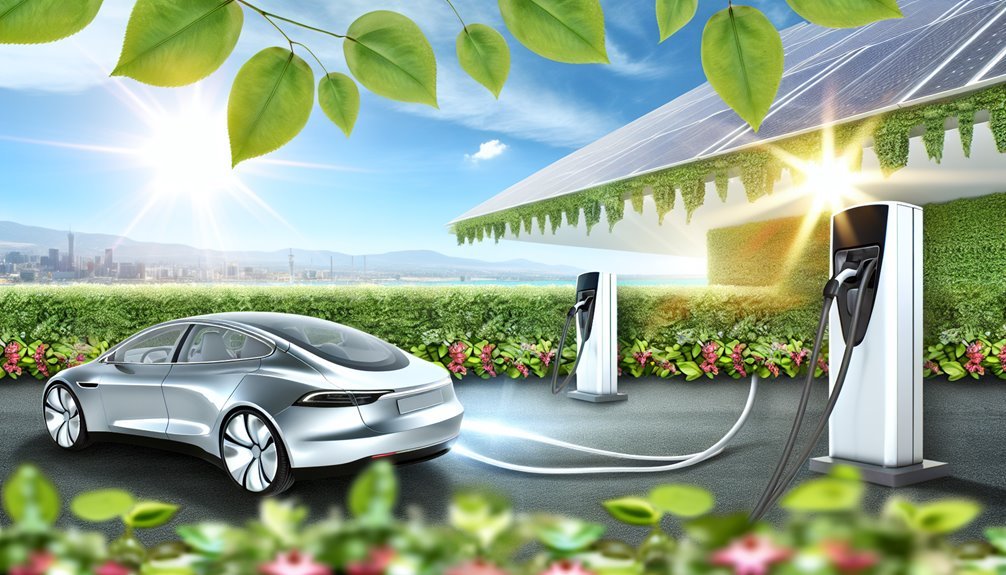Electric vehicles (EVs) are transforming the way we think about transportation, offering substantial benefits that extend beyond just personal convenience. You’ll find that these vehicles markedly reduce emissions, leading to cleaner air and better public health. Plus, they can save you money over time with lower fuel and maintenance costs. But there’s more to explore about how EVs impact our communities and the economy—are you ready to uncover these insights?
Key Takeaways
- Electric vehicles (EVs) produce zero tailpipe emissions, improving air quality and reducing health risks, particularly in low-income communities.
- EVs offer significant cost savings through lower fuel and maintenance expenses, along with federal and state tax incentives.
- The expanding network of over 77,000 public charging stations enhances accessibility and reduces range anxiety for EV users.
- The transition to EVs is projected to create over 10,000 new jobs and stimulate economic growth in local communities.
- EVs contribute to urban noise reduction and enhance energy security by decreasing dependence on fossil fuels and supporting renewable energy initiatives.
Environmental Impact and Public Health
As more people consider making the switch to electric vehicles (EVs), it is vital to understand their profound environmental impact and public health benefits. EVs produce zero tailpipe emissions, drastically cutting health-harming air pollutants that contribute to tens of thousands of premature deaths annually in the U.S. By shifting to EVs, you could help save approximately 6,300 lives each year and greatly reduce asthma attacks, particularly in low-income communities and communities of color disproportionately affected by air pollution. California’s move towards EVs illustrates these public health benefits, showing improved air quality and fewer asthma-related hospital visits. By 2050, widespread EV adoption could save Angelenos around $12.6 billion in healthcare costs, highlighting the economic advantages of reducing greenhouse gas emissions through electric transportation. Additionally, reducing exposure to EMF radiation can further enhance overall health and well-being in communities transitioning to cleaner transport options.
Cost Savings and Financial Incentives
When pondering the switch to electric vehicles (EVs), you’ll find that the cost savings and financial incentives can greatly enhance their appeal. Here are some key factors to reflect on:
- Lower Operating Costs: EVs typically have reduced fuel and maintenance expenses compared to gasoline vehicles.
- Federal Tax Credits: Programs like the Clean Vehicle Tax Credit can considerably lower your initial costs.
- State Incentives: Many states offer additional rebates to promote EV adoption, further decreasing the purchase price.
- Favorable Electricity Rates: Charging during off-peak hours can lead to lower energy costs, enhancing your savings.
Additionally, being prepared with alternative power sources can further contribute to your overall savings during emergencies and unexpected situations. As gasoline prices rise, these factors make EVs an economically smart choice for innovative consumers looking to save money.
Fuel Efficiency and Economy
Fuel efficiency is a standout feature of electric vehicles (EVs), making them an attractive option for environmentally conscious drivers and budget-savvy consumers alike. With impressive fuel economy often exceeding 130 miles per gallon equivalent (MPGe), EVs leave conventional vehicles in the dust; for instance, the 2024 Toyota Corolla Hybrid achieves just 50 MPG compared to 35 MPG for its gas counterpart. Beyond fuel economy, the operating costs of EVs are considerably lower due to reduced maintenance needs—fewer moving parts mean fewer repairs. Plus, with electricity prices generally being more stable and lower than gasoline, charging your EV during off-peak hours can enhance cost savings. Embracing EVs means not just sustainability, but also smarter financial choices.
Battery Longevity and Reliability
Battery longevity and reliability are essential factors in the overall appeal of electric vehicles (EVs). Modern battery technologies have transformed the landscape of EVs, ensuring that you can trust their performance for years to come. Here’s why advanced batteries are a smart choice:
- Lifespan: Most EV batteries last between 12 to 15 years, with warranties of 8 years or 100,000 miles.
- Failure Rate: Older models have a mere 2.5% failure rate, while newer models show less than 0.5%.
- Durability: Over 97.5% of EVs are still using their original batteries, proving their reliability.
- Innovation: Ongoing research found that advances in battery recycling and technology will enhance both lifespan and environmental impact.
Investing in an EV means investing in dependable battery performance.
Infrastructure Development and Availability
As you consider switching to an electric vehicle, the growing network of charging stations across the U.S. becomes a key factor. With over 60,000 public charging stations and significant government investment, access to charging infrastructure is improving rapidly, even in rural areas. This expansion not only enhances convenience but also supports the broader adoption of EVs, making it easier for you to meet your daily driving needs.
Charging Station Accessibility
While you’re steering through the shift to electric vehicles (EVs), one of the most significant factors influencing your experience is the accessibility of charging stations. With over 60,000 public charging stations and 162,000 ports available across the U.S., the EV charging infrastructure is rapidly evolving to meet your needs. Here are some key points to take into account:
- The U.S. government has invested $7.5 billion to enhance charging accessibility.
- You can charge overnight at home or at workplaces, offering flexibility.
- Standard 120 Volt outlets are available for daily use, while 240 Volt options provide faster charging.
- A growing network of stations reduces range anxiety, making long-distance travel more feasible.
This accessibility is essential for embracing electric vehicles and their benefits.
Public Infrastructure Growth
With the rapid growth of electric vehicle (EV) adoption, the expansion of public infrastructure is essential for supporting this shift. Over 60,000 public charging stations and more than 162,000 charging ports across the U.S. enhance accessibility, making it easier for you to charge on the go. The Bipartisan Infrastructure Law’s $7.5 billion allocation specifically targets EV charging infrastructure, ensuring a reliable network of public charging stations nationwide. While many EV owners can charge at home, these public options are critical for long journeys and urban commutes. As government initiatives prioritize deployment in rural areas, clean transportation becomes accessible to all communities, paving the way for a sustainable future. Embracing this infrastructure growth is fundamental for your EV experience and environmental impact.
Rural Connectivity Initiatives
To guarantee that electric vehicle (EV) adoption isn’t limited to urban areas, initiatives focused on rural connectivity are essential. Enhancing the EV charging network in these regions not only supports drivers but also stimulates local economies. Here are key benefits of developing charging infrastructure in rural communities:
- Increased Accessibility: More charging stations make EVs practical for rural residents.
- Economic Growth: Local businesses can thrive as EV drivers stop to charge and shop.
- Job Creation: Establishing and maintaining charging networks creates job opportunities.
- Attracting Tourism: Improved connectivity can draw regional travelers, fostering community ties.
Investing in rural charging infrastructure isn’t just about convenience; it’s a pathway to innovation and sustainable economic development.
Economic Growth and Job Creation
The electric vehicle (EV) sector is driving remarkable economic growth and job creation across the United States. Between 2020 and 2021, EV jobs surged by 26.2%, showcasing strong expansion. With a quarter of global EV investments projected for the U.S. through 2030, the country is positioning itself as a leader in this innovative market. Federal EV investment, spurred by the Bipartisan Infrastructure Law and Inflation Reduction Act, allocates $245 billion for infrastructure and domestic production, creating high-quality jobs in autoworking, construction, and electrical fields. These initiatives are expected to generate over 10,000 new jobs, fostering economic growth while ensuring equitable benefits across diverse communities. Embracing clean energy through EVs not only transforms transportation but also fuels job opportunities nationwide.
Noise Reduction and Urban Quality of Life
As urban areas grapple with rising noise pollution, the change to electric vehicles (EVs) offers a promising solution that can enhance quality of life. EVs operate nearly silently at low speeds, greatly reducing noise in crowded cities. This shift is vital for public health, as chronic noise pollution from traditional vehicles is linked to stress and sleep disturbances.
The transition to electric vehicles can significantly reduce urban noise pollution, enhancing public health and quality of life.
Here are four key benefits of EVs for urban environments:
- Reduced Noise Levels: Quieter streets create a more serene atmosphere.
- Health Improvement: Less noise pollution can lead to fewer stress-related health issues.
- Enhanced Community Well-being: A pleasant soundscape makes cities more enjoyable.
- Safety Balance: External speakers on EVs alert pedestrians without adding to noise pollution.
Together, these factors contribute to a healthier urban lifestyle.
Energy Security and Resilience
When you choose an electric vehicle (EV), you’re not just opting for a cleaner ride; you’re also boosting energy security by reducing our dependence on fossil fuels. EVs enhance grid stability by allowing for local energy generation and efficient charging during off-peak hours. With advancements like vehicle-to-grid technology, your EV can even support the power grid during peak demand, making our energy systems more resilient.
Reduced Fossil Fuel Dependence
Reducing dependence on fossil fuels through electric vehicles (EVs) not only helps combat climate change but also strengthens energy security and resilience. By shifting to EVs, you can enjoy several benefits:
- Utilization of Renewable Energy Sources: EVs can be powered by solar, wind, and hydroelectric energy, minimizing fossil fuel consumption.
- Reduced Greenhouse Gas Emissions: The transportation sector is a major contributor to U.S. emissions; EVs considerably lower this impact.
- Support for Domestic Energy Production: Increased electricity demand can be met with local resources, reducing reliance on foreign oil.
- Enhanced Energy Independence: Widespread EV adoption by 2050 could drastically cut fossil fuel use, mitigating economic risks tied to volatile oil prices.
Embrace the future of transportation and energy security!
Enhanced Grid Stability
Electric vehicles (EVs) not only represent a shift in transportation but also play an essential role in enhancing grid stability and energy resilience. By charging during off-peak hours, you help balance electricity demand, reducing strain on the grid. The emerging vehicle-to-grid (V2G) technology enables your EVs to supply energy back, ensuring reliability during peak demand times. As we progress to renewable energy, increased EV adoption supports grid resilience, offering cleaner energy options. Research shows our existing power grid can handle EV market growth without collapse. Investments in charging infrastructure, like the $7.5 billion from the Infrastructure Investment and Jobs Act, are set to fortify our charging network, ultimately enhancing grid stability for everyone involved.
Local Energy Generation
As communities increasingly turn to local energy generation through renewable sources like solar and wind, they’re not only bolstering their energy security but also gaining resilience against fluctuating energy prices. By integrating electric vehicles (EVs) into local energy systems, you can harness vehicle-to-grid (V2G) technology for added benefits. Here are a few key advantages:
- Reduced Dependence: You’ll decrease reliance on external energy supplies, stabilizing costs.
- Lower Emissions: Localized energy generation helps cut greenhouse gas emissions, supporting net-zero goals.
- Job Creation: Investing in this infrastructure stimulates economic growth and creates employment opportunities.
- Health Benefits: Cleaner energy contributes to improved air quality, enhancing public health outcomes.
Embracing local energy generation with EVs leads to a sustainable, resilient future.
Community Benefits and Local Business Opportunities
How can communities truly thrive in the era of electric vehicles? By investing in charging infrastructure, you can attract EV drivers who prioritize convenience. This not only encourages them to shop or dine locally while their vehicles charge but also boosts local businesses. Additionally, the electric vehicle sector is rapidly expanding, adding thousands of jobs and driving economic development. Local businesses can tap into federal funding opportunities to support this growth, creating jobs and enhancing community connections. As charging networks expand, they’ll link rural areas to the broader EV ecosystem, stimulating local economies. Embracing this innovation can turn your community into a hub for EV drivers, benefiting everyone involved.
Common Misconceptions About Electric Vehicles
You might think electric vehicles (EVs) are worse for the climate or that their batteries don’t last long, but the reality is quite different. Research shows EVs usually have a smaller carbon footprint, and modern batteries are built to last over a decade. Plus, as charging infrastructure expands, your concerns about range and power grid impacts can be put to rest.
Power Plant Emissions Misunderstood
While many people believe that electric vehicles (EVs) contribute considerably to power plant emissions, this misconception overlooks the broader context of their environmental impact. In reality, EVs are often more sustainable than gasoline vehicles due to several factors:
- EVs use 87%-91% of battery energy, while gasoline cars only convert 16%-25% of fuel energy into movement.
- As the grid shifts towards renewable energy, the overall greenhouse gas emissions from EVs continue to decline.
- Studies from Argonne National Laboratory show that total GHG emissions from EVs, including those from battery manufacturing, remain lower than those of average gasoline cars.
- Battery recycling initiatives further reduce carbon pollution, enhancing the sustainability of electric vehicles.
Embracing EVs can lead to a cleaner, greener future.
Battery Life Concerns Addressed
As concerns about battery life persist among potential electric vehicle (EV) buyers, it’s essential to separate fact from fiction. Modern battery technology has made significant strides, with EV batteries typically lasting between 12 to 15 years and warranties covering 8 years or 100,000 miles. You’ll be pleased to know that the failure rate for these batteries is remarkably low, at less than 0.5%. In fact, 97.5% of EVs still operate on their original batteries. While factors like climate and driving patterns can influence battery life, ongoing advancements promise even greater longevity. Although replacement battery costs may seem high now, they are expected to decline as EV manufacturing evolves, making electric vehicles an increasingly viable and innovative option for the future.
Charging Infrastructure Expansion Benefits
The rapid expansion of charging infrastructure is transforming common misconceptions about electric vehicles (EVs) into a reality of convenience and accessibility. With over 77,000 public charging stations across the U.S., you can easily find a place to power up your EV. Here are some benefits of this growth:
- Increased Accessibility: More charging ports mean less range anxiety for drivers.
- Convenient Charging Options: You can charge at home, work, or during errands, often during off-peak hours.
- Government Support: Initiatives like the $7.5 billion investment boost EV adoption.
- Economic Benefits: Expanding infrastructure supports local businesses and attracts travelers.
Embracing this growth means a smarter, more sustainable future for everyone.





Leave a Reply